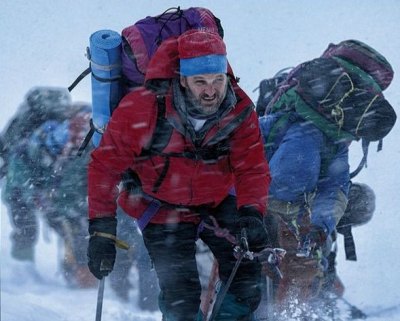Everest: Breathing lessons on the mountain

Despite stunning scenery and magnificent actors (Jason Clarke, Josh Brolin, Jake Gyllenhaal and Keira Knightley, among others), the movie Everest is tough to watch. The story is based on a true and horrific event -- the deaths of eight climbers during a storm on the mountain May 10-11, 1996.
But an interesting scientific issue underlies the story: What happens to the human body at 29,029 feet? To understand, we start by contemplating a line from the movie: “Human beings simply aren’t built to function at the cruising altitude of a 747.”
So why is it so difficult to breathe on top of a mountain?
First, let’s think about something we take for granted: air.Air on our planet is composed of 20 percent oxygen and 80 percent nitrogen. The atmosphere is defined by Webster’s as a “gaseous mass enveloping a celestial body (a planet)” or, specifically, “the whole mass of air surrounding the Earth.”
Now let’s think about air pressure or atmospheric pressure, which the dictionary defines as “the pressure exerted in every direction at any given point by the weight of the atmosphere.”
At sea level, then, you have plenty of air. But everything changes when you are climbing a mountain. As explained by ScienceLine, a project of the National Science Foundation and the University of California Santa Barbara: “There is less air above you to push down on you and squeeze the air molecules together around you.”
Who are the Sherpas? Do they have the same problem?
The Sherpas are people who live in the Himalayas. Famously, Sherpa Tenzing Norgay and Sir Edmund Hillary were the first to reach the summit of Everest in 1953. The Sherpas have been very involved in climbing expeditions.
“Sherpas and Tibetans … may have been living at high altitude for longer than any other population, and the hypothesis of a possible evolutionary genetic adaptation to altitude makes sense,” according to research published through the U.S. National Library of Medicine. Tibetans have larger lungs and better lung function, researchers explained. They adapt better to high-altitude work, “and this superior adaptation may very well be inborn, even though its exact genetic basis remains to be elucidated.”
Some scientists believe that Sherpas and Tibetans have actually evolved, over time, in a way that helps them adapt to the thin air. “By impairing both function and survival, the severe reduction in oxygen availability associated with high-altitude environments is likely to act as an agent of natural selection,” researchers wrote in a 2010 article published in the Proceedings of the National Academy of Sciences.
Even so, Sherpas also use oxygen at high altitudes. And they, too, are victims of the mountain. In 2014, 13 Sherpas died in an avalanche, described by National Geographic as the worst accident in the history of Everest.
Why do climbers sometimes make the mistake of taking their gloves off – despite temperatures well below zero?
In cold, especially extreme cold, climbers suffer hypothermia – defined in the Bantam Medical Dictionary as the “accidental reduction in body temperature below the normal range in the absence of protective reflex actions, such as shivering.”
The body loses heat faster than it can produce heat, according to the Mayo Clinic online. The heart, nervous system and other organs can’t function normally. At first, symptoms include shivering, dizziness, hunger, faster breathing, trouble speaking, slight confusion and increased heart rate.
In more severe cases, symptoms include “confusion and poor decision-making, such as trying to remove warm clothes,” the Mayo website said.
Sources:
- The Bantam Medical Dictionary, Laurence Urdang (Mass Market Paperback; 2009).
- BBC: What extreme cold does to humans.
- Mayo Clinic: Hypothermia.
- Merriam-Webster.com: Atmospheric pressure.
- National Oceanic and Atmospheric Administration (NOAA): How does pressure change with ocean depth?
- National Institutes of Health website: High Altitude Adaptation in Tibetans, Wu T., Kayser B. (published in the journal, High Altitude Medicine and Biology, 2006).
- Proceedings of the National Academy of Sciences: Natural selection on EPAS1 (HIF2α) associated with low hemoglobin concentration in Tibetan highlanders, (2010), Beall, Cynthia M., et al.
- PBS-NOVA: Everest history.
- PBS: NOVA, Trying to Breathe on Mount Everest.
- ScienceLine --University of California at Santa Barbara: How much oxygen does the air have in it at 20 feet above sea level.
- University of Illinois Extension Service: Air pressure.
If you would like to comment, contact us or like us on Facebookand tell us what you think.

